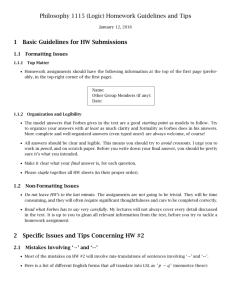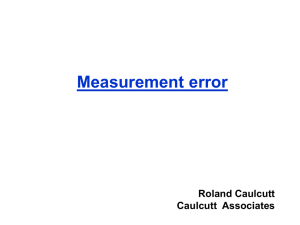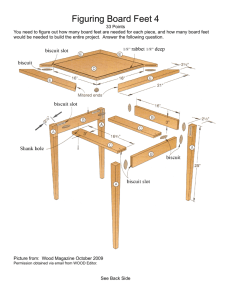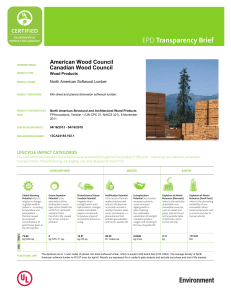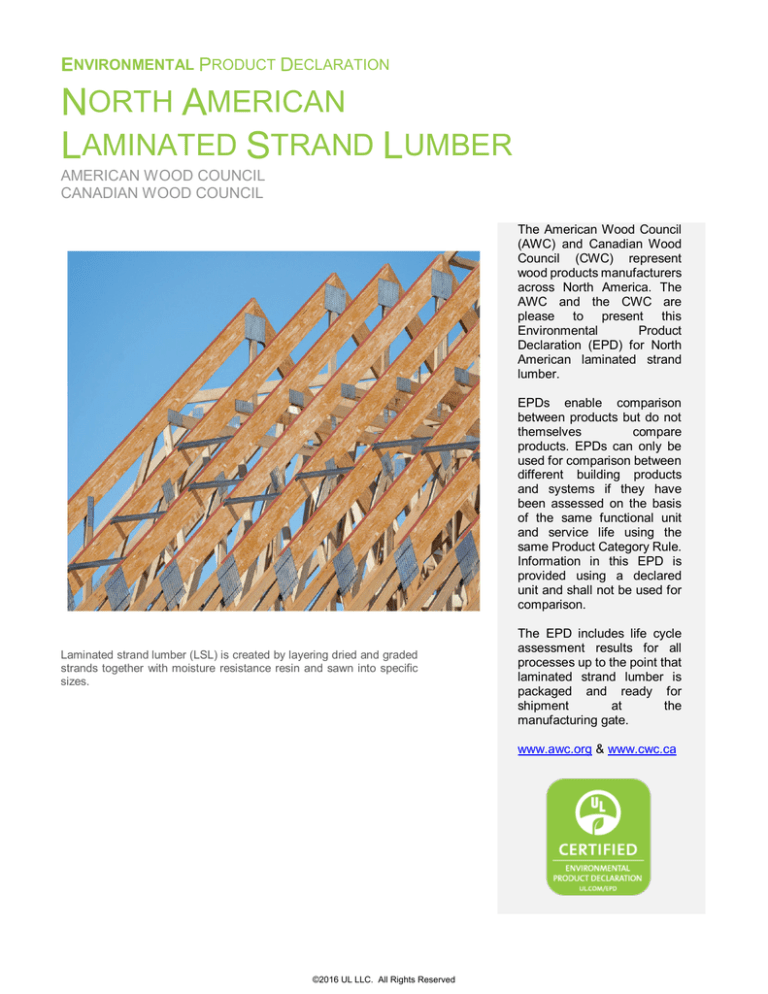
ENVIRONMENTAL PRODUCT DECLARATION
NORTH AMERICAN
LAMINATED STRAND LUMBER
AMERICAN WOOD COUNCIL
CANADIAN WOOD COUNCIL
The American Wood Council
(AWC) and Canadian Wood
Council (CWC) represent
wood products manufacturers
across North America. The
AWC and the CWC are
please to present this
Environmental
Product
Declaration (EPD) for North
American laminated strand
lumber.
EPDs enable comparison
between products but do not
themselves
compare
products. EPDs can only be
used for comparison between
different building products
and systems if they have
been assessed on the basis
of the same functional unit
and service life using the
same Product Category Rule.
Information in this EPD is
provided using a declared
unit and shall not be used for
comparison.
Laminated strand lumber (LSL) is created by layering dried and graded
strands together with moisture resistance resin and sawn into specific
sizes.
The EPD includes life cycle
assessment results for all
processes up to the point that
laminated strand lumber is
packaged and ready for
shipment
at
the
manufacturing gate.
www.awc.org & www.cwc.ca
©2016 UL LLC. All Rights Reserved
Page 2 of 18
According to ISO 14025 and ISO 21930
North American Laminated Strand Lumber (LSL)
North American Structural and Architectural Wood Products
This declaration is an environmental product declaration (EPD) in accordance with ISO 14025. EPDs rely on Life Cycle
Assessment (LCA) to provide information on a number of environmental impacts of products over their
life cycle. Exclusions: EPDs do not indicate that any environmental or social performance benchmarks
are met, and there may be impacts that they do not encompass. LCAs do not typically address the sitespecific environmental impacts of raw material extraction, nor are they meant to assess human health
toxicity. EPDs can complement but cannot replace tools and certifications that are designed to address
these impacts and/or set performance thresholds – e.g. Type 1 certifications, health assessments and
declarations, environmental impact assessments, etc. Accuracy of Results: EPDs regularly rely on
estimations of impacts, and the level of accuracy in estimation of effect differs for any particular product
line and reported impact. Comparability: EPDs are not comparative assertions and are either not comparable or have
limited comparability when they cover different life cycle stages, are based on different product category rules or are
missing relevant environmental impacts. EPDs from different programs may not be comparable.
PROGRAM OPERATOR
DECLARATION HOLDER
DECLARATION NUMBER
UL Environment
American Wood Council
4787193543.101.1
DECLARED PRODUCT
REFERENCE PCR
Laminated Strand Lumber
FP Innovations. 2015. Product Category Rules (PCR) for preparing and environmental
Product Declaration (EPD) for North American Structural and Architectural Wood
Products. https://fpinnovations.ca/ResearchProgram/environment- sustainability/epdprogram/Documents/pcr-v2.pdf.
February 24, 2016
5 Years
Product definition and information about building physics
DATE OF ISSUE
PERIOD OF VALIDITY
CONTENTS
OF
DECLARATION
Information about basic material and the material’s origin
Description of the product’s manufacture
THE
Indication of product processing
Information about the in-use conditions
Life cycle assessment results
Testing results and verifications
FP Innovations
PCR review committee
info@fpinnovations.ca
The PCR review was conducted by:
This declaration was independently verified in accordance with ISO
14025 by Underwriters Laboratories
☐ INTERNAL
☒ EXTERNAL
This life cycle assessment was independently verified in accordance
with ISO 14044 and the reference PCR by:
Wade Stout, UL Environment
Thomas Gloria, Industrial Ecology Consultants
©2016 UL LLC. All Rights Reserved
Page 3 of 17
North American Laminated Strand Lumber (LSL)
North American Structural and Architectural Wood Products
According to ISO 14025 and ISO 21930
Description of Industry and Product
Description of North American Laminated Strand Lumber Industry
The North American forest products industry is a major contributor to both the United States and Canadian economies.
Wood manufacturing jobs, including those required to produced laminated strand lumber (LSL) serve as the primary
economic drivers in rural areas of both countries. In 2013, North American LSL manufacturers production capacity was
over 11.2 million cubic feet (316 thousand cubic meters).
LSL is part of a family of structural composite lumber (SCL). LSL is a growing segment of the SCL industry and is used
in various applications that take advantage of its uniform engineering properties. Most commonly LSL is used in headers
and beams, wall stud applications, roof beams and rafters, truss chords, rim board, and stair stringers. The material
properties of LSL are dependent on the density of the panel, the strand species, and the orientation of strands. LSL can
be produced from forest resources that are less suitable for other building materials in that it can and is made from
smaller diameter, low quality trees. The primary species used in North America are a mixture of aspen, birch, and maple.
Two LSL manufacturers contributed production data from the United States and Canada. No LSL manufacturers were
in operation in Mexico (Table 1).
Table 1. North American Laminated Strand Lumber Manufacturers (2013)
Manufacturer
City
State/Province, Country
Louisiana-Pacific Corp
Houlton
Maine, United States
Weyerhaeuser
Kenora
Ontario, Canada
©2016 UL LLC. All Rights Reserved
Page 4 of 17
North American Laminated Strand Lumber (LSL)
North American Structural and Architectural Wood Products
According to ISO 14025 and ISO 21930
Description of Laminated Strand Lumber Product
The manufacturing process of LSL begins by cutting small veneers directly from whole logs. The veneers (strands) are
dried to remove moisture and then sprayed using a waterproof “formaldehyde free” adhesive which bond the strands
together under steam and pressure. At the end of production, LSL has a final moisture content of 7 to 10 percent (dry
basis). Production is measured on volume (cubic feet (ft3) or cubic meters (m3)) at varying thicknesses, widths, and
lengths.
The product profile presented in this EPD is for a declared unit of 1 cubic meter of LSL. One cubic meter of average
North American LSL weighs 570.22 kg excluding moisture. The product composition is presented below and represents
the weighted average of the resin and wax used in LSL manufacturing.
−
−
−
Wood: oven dry 533.22 kg (93.50%)
Methylene diphenyl diisocyanate resin: 31.18 kg (5.99%)
Wax: 2.88 kg (0.50%)
This EPD is based on LCA studies that considered the entire range of LSL product sizes and functions. For reference
purposes, the results are provided for 1 cubic meter of finished product which is equal to 35.31 cubic feet.
©2016 UL LLC. All Rights Reserved
Page 5 of 17
North American Laminated Strand Lumber (LSL)
North American Structural and Architectural Wood Products
Cradle-to-Gate Life Cycle of LSL
Figure 1 Cradle-to-gate system boundary for LSL
©2016 UL LLC. All Rights Reserved
According to ISO 14025 and ISO 21930
Page 6 of 17
North American Laminated Strand Lumber (LSL)
North American Structural and Architectural Wood Products
According to ISO 14025 and ISO 21930
Forest Operations
The PCR requires that the production system include extraction of raw materials including reforestation activities.
Therefore, the life cycle assessment of a wood product includes the energy use and emissions from all forestry
operations which include plantation establishment, management, and harvesting. In the EPD for LSL, the cradle-to-gate
product system begins with the establishment of a natural or managed forest by natural regeneration or planting of
seedlings, respectively. The boundary also encompasses all forest management activities which may include site
preparation, thinning, and fertilization.
LSL Production
The LSL production phase begins with the transportation of the logs to the mill by truck. Once the logs reach the mill,
the manufacturing process begins with a whole logs cut to length, de-barked, and submerged in conditioning ponds.
Logs are then cut into strands, screened, dried to a control moisture content, bonded with non-formaldehyde resin, and
pressed. Grade marks and logos are applied to the surface of each piece LSL. Finished boards stamped boards are
coated with an edge-seal stacked in bundles and cut to specific lengths. These processes consume electricity drawn
from regional grids, fossil fuels, and internally generated woody biomass.
Packaging of Laminated Strand Lumber
Laminated strands boards are stacked in bundles, wrapped, and strapped into finished units for short term storage or
immediate shipping. Packaging materials can include recyclable polypropylene waterproof wrapping, plastic strapping,
and cardboard to protect strapping from damaging boards. Wrapping material and strapping can vary between
manufacturers. Wood spacers can be used between units for ease of transferring units using forklifts. Packaging materials
represent less than 1.0 percent of the cumulative mass of the model flow.
©2016 UL LLC. All Rights Reserved
Page 7 of 17
North American Laminated Strand Lumber (LSL)
North American Structural and Architectural Wood Products
According to ISO 14025 and ISO 21930
Methodology of Underlying LCA
Business-to-business EPD and Cradle-to-Gate LCA
Business-to-business (B-to-B) EPDs include the life cycle of the product up to the point that the product has been
manufactured and is ready for shipment. This is commonly referred to as a cradle-to-gate life cycle assessment. The
cradle-to-gate processes included in this EPD are outlined in Figure 1. The use phase and end of life scenarios can be
omitted in a B-to-B EPD.
This Type III environmental declaration is developed according to ISO 21930 and 14025 for laminated strand lumber.
This EPD reports environmental impacts based on established life cycle impact assessment methods. The reported
environmental impacts are estimates, and their level of accuracy may differ for a particular product line and reported
impact. LCAs do not generally address site-specific environmental issues of related to resource extraction or toxic effects
of products on human health. Unreported environmental impacts include (but are not limited to) factors attributable to
human health, land use change and habitat destruction. Forest certification systems and government regulations address
some of these issues. In this EPD the woody residues used in the production of LSL coming from Canadian and US
forests are harvested under the applicable federal, provincial, and state laws. EPDs do not report product environmental
performance against any benchmark.
Declared Unit
In accordance with the PCR, the declared unit for LSL is one cubic meter (m3) which is equal to 35.31 cubic feet. The
average density of North American LSL including resins and excluding moisture is 570.28 kg/m3 oven dry. LSL produced
in North America can have a 7–10 percent moisture content therefore the final weight of product will be variable.
System Boundaries
The system boundary begins with the planting, growth and harvest of trees in North American and ends with LSL
packaged to leave the mill gate. The forest resources system boundary includes: forest regeneration and stand
management, felling the trees, removing limbs, transportation of logs to landing, and cutting to shipping lengths.
Excluded from forestry operations are maintenance and repair of equipment, and building and maintenance of logging
roads, logging camps, and weigh stations. The transportation of logs from the woods to the mill is accounted for with the
LSL manufacturing. The LSL production process includes log yard operations and primary log breakdown. Outputs
include 1 m3 of LSL ready to be shipped, air and water emissions, solid waste, and co-products.
©2016 UL LLC. All Rights Reserved
Page 8 of 17
North American Laminated Strand Lumber (LSL)
North American Structural and Architectural Wood Products
According to ISO 14025 and ISO 21930
Cut-Off rules
The cut-off criteria for flows to be considered within the system boundary are as follows:
−
Mass – if a flow is less than 1% of the cumulative mass of the model flows, it may be excluded, provided its
environmental relevance is minor.
−
Energy – if a flow is less than 1% of the cumulative energy of the model flows, it may be excluded, provided its
environmental relevance is minor.
−
Environmental relevance – if a flow meets the above two criteria, but is determined (via secondary data analysis) to
contribute 2% or more to the selected impact categories of the products underlying the EPD, it is included within the
system boundary.
Data Quality
Precision and Completeness
Primary data on raw materials, energy, and emissions were provided by LSL manufacturing facilities, based on purchase
inputs, production outputs, and reported process emissions. All upstream and downstream secondary data (e.g. forestry
operations and fuel production) were drawn from publically available databases, primarily the United States Life Cycle
Inventory (USLCI) database and other public LCI data sources. The LCA practitioners performed quality control on all
secondary data sources to ensure completeness.
All inventory flows were modeled and no data were excluded due to application of the EPD cut-off criteria.
Consistency and Reproducibility
To ensure consistency, only primary data as provided by the LSL manufacturers, were used to model gate-to-gate LSL
manufacturing processes. All other secondary data (upstream and downstream) were consistently applied and
adaptations to the databases were documented in the LCA reports.
Reproducibility by third parties is possible using the background LCIs documented in the CORRIM and Athena reports.
Temporal Coverage
Primary data collected from the manufacturing facilities related to the product processes of interest are representative
for the year 2013.
Geographic Coverage
The geographical coverage for this EPD is based on North American (NA) system boundaries for all processes and
products.
©2016 UL LLC. All Rights Reserved
Page 9 of 17
North American Laminated Strand Lumber (LSL)
North American Structural and Architectural Wood Products
According to ISO 14025 and ISO 21930
Treatment of Biogenic Carbon
Biogenic carbon dioxide emissions were counted as global warming neutral in accordance with the PCR. Under this
approach, the carbon dioxide emissions from the combustion of internally generated wood fuels are considered equal to
the carbon dioxide uptake in the forest during tree growth.
Crediting carbon sequestration against the global warming potential was excluded as the long term carbon storage is
dependent on gate-to-grave processes not considered directly in this EPD. The expected carbon sequestration for
average end-use and end-of-life treatment is provided in the section on “Additional Information.”
Allocation
An economic allocation was used in the LCA of laminated strand lumber. According to the PCR (FPInnovations 2015)
if one or more co-products are generated during the production process, it is necessary to allocate the inputs and
outputs using a standardized approach. The LCA on LSL follows the allocation rules which states that when the total
revenues between the main product and co-products is more than 10%, allocation shall be based on the revenue
[economic] allocation. The 10% rule is applied based on a per unit basis, in this case per m3 of LSL.
Laminated strand lumber is a single-output process and thus no allocation was applied to the manufacturing gate-togate process. The wood fiber input (logs with bark) was also treated in this manner since the value of strands as the
main wood fiber product far exceeded the other coproducts.
Data Collection and Calculation Methods
Primary data for the LCI was collected through surveys. This study relied almost exclusively on production inputs and
emissions data provided by LSL producers in North America, with some secondary data from the USLCI database. All
allocation was based on the value (economic allocation) of the products and co-products. Survey data were converted
to a unit production basis of 1 cubic meter and a weighted average of input data was calculated based on production
data.
©2016 UL LLC. All Rights Reserved
Page 10 of 17
North American Laminated Strand Lumber (LSL)
North American Structural and Architectural Wood Products
According to ISO 14025 and ISO 21930
Life Cycle Assessment Results
The life cycle impact assessment (LCIA) established links between the life cycle inventory results and the potential
environmental impacts. In the LCIA, results are calculated for impact category indicators such as global warming
potential and smog potential. These impact category indicator results provide general, but quantifiable, indications of
potential environmental impacts. The various impact category indicators and means of characterizing the impacts are
summarized in Table 1. Consistent with the requirements of the PCR, five impact categories are reported in Table 2.
The TRACI 2 method was used to characterize the reported environmental impacts.
Table 2: Impact Assessment Categories
Impact Category Indicators
Characterization Model
Global
Warming
Potential
Calculates global warming potential of all greenhouse gasses that are
recognized by the IPCC. The characterization model scales substances
that include methane and nitrous oxide to the common unit of kg CO2
equivalents.
Ozone
Depletion
Potential
Calculates potential impact of all substances that contribute to
stratospheric ozone depletion. The characterization model scales
substances that include CFC’s, HCFC’s, chlorine, and bromine to the
common unit of CFC-11 equivalents.
Acidification
Potential
Calculates potential impacts of all substances that contribute to terrestrial
acidification potential. The characterization model scales substances that
include sulfur oxides, nitrogen oxides, and ammonia to the common unit of
kgSO2 equivalents.
Smog
Potential
Calculates potential impacts of all substances that contribute to
photochemical smog potential. The characterization model scales
substances that include nitrogen oxides and volatile organic compounds to
the common unit of kg O3 equivalents.
Eutrophication
Potential
Calculates potential impacts of all substances that contribute to
eutrophication potential. The characterization model scales substances
that include nitrates and phosphates to the common unit of kg N
equivalents.
©2016 UL LLC. All Rights Reserved
Page 11 of 17
North American Laminated Strand Lumber (LSL)
North American Structural and Architectural Wood Products
According to ISO 14025 and ISO 21930
Cradle-to-Gate Impact Assessment
Modules included in the EPD are (Table 3): A1- Raw material supply, which includes resource extraction, A2 –
Transportation of resource to LSL, and A3 – Laminated strand lumber production. The impact assessment results for
LSL are shown in Table 4. This LCIA does not make value judgments about the impact indicators, meaning that no
single indicator is given more or less value than any of the others. All are presented as equals. Each impact indicator
summarizes a different group of environmental emissions based on their pathway to potential impact using units that
are common within the group but not comparable between groups. For this reason the indicators should not be
combined or added.
The results presented below indicate the potential impacts caused by the cradle-to-gate production of LSL. Ozone
depletion was below 10-5 kg CFC eq. for both Forestry Operations and LSL Production and is thus not reported in the
results. Water consumption was a total from the LCI as required by the PCR and includes all water withdrawals without
netting out non-consumptive use. As a result, the total water consumption is a conservative value which may overstate
the use.
Table 3. Life cycle stages included in the LCA.
Construction
process
Stage
Benefits and loads
beyond the system
boundary
Manufacturing
Transport from the
gate to the site
Assembly
Use
Maintenance
Repair
Replacement
Refurbishment
Operational energy
use
Operational water
use
De-construction
demolition
Transport
Waste processing
Disposal
ReuseRecoveryRecyclingpotential
End of life stage
Transport
Use stage
Raw material
supply
Product stage
A1
A2
A3
A4
A5
B1
B2
B3
B4
B5
B6
B7
C1
C2
C3
C4
D
X
X
X MND MND MND MND MND MND MND MND MND MND MND MND MND
X = modules included in the study
MND = Module not declared
©2016 UL LLC. All Rights Reserved
MND
Page 12 of 17
North American Laminated Strand Lumber (LSL)
North American Structural and Architectural Wood Products
According to ISO 14025 and ISO 21930
Table 4: Cradle-to-Gate Impact Assessment Results - 1 m3 North American LSL
Impact category Indicator
Unit
Total
Forestry
Operations
LSL
Production
Global warming potential
Acidification Potential
kg CO2 eq.
kg SO2 eq.
310.28
2.41
29.31
0.14
280.97
2.27
Eutrophication Potential
Ozone depletion Potential
Smog Potential
Total primary energy
consumption
kg N eq.
kg CFC-11 eq.
kg O3 eq.
0.0709
0.0000
34.05
Unit
Total
0.0072
0.0000
3.26
Forestry
Operations
0.0637
0.000
30.79
LSL
Production
Non-renewable, fossil
Non-renewable, nuclear
Renewable, biomass
Renewable, other
Material resources
consumption
MJ
MJ
MJ
MJ
4810.87
1281.70
7574.23
165.83
Unit
Total
439.81
5.94
0.03
0.85
Forestry
Operations
4371.06
1275.75
7574.21
164.99
LSL
Production
Non-renewable materials
kg
17.00
0.00
17.00
Renewable materials
Fresh water
Non-hazardous waste
generated
kg
L
877.98
178.09
Unit
Total
877.98
0.00
Forestry
Operations
0.00
178.09
LSL
Production
Solid waste
kg
35.26
0.45
34.80
©2016 UL LLC. All Rights Reserved
Page 13 of 17
North American Laminated Strand Lumber (LSL)
North American Structural and Architectural Wood Products
According to ISO 14025 and ISO 21930
Impact Assessment Results by Life Stage
The two graphs below show the LSL manufacturing life cycle stage is the primary driver of impacts in the cumulative
cradle-to-grave product system. Laminated strand lumber manufacturing consumes 91% of fossil fuels and 100% of
biomass energy which drives the impacts in all categories.
Figure 2: Cradle-to-Gate Impact Assessment Results
100%
90%
80%
70%
60%
50%
40%
30%
20%
10%
0%
Global warming
Acidification
Forestry Operations
Eutrophication
Smog
LSL Production
Figure 3: Cradle-to-Gate Energy Primary Consumption
100%
90%
80%
70%
60%
50%
40%
30%
20%
10%
0%
Non-renewable fossil
Non-renewable nuclear
Forestry Operations
Renewable, biomass
LSL Production
©2016 UL LLC. All Rights Reserved
Renewable, other
Page 14 of 17
North American Laminated Strand Lumber (LSL)
North American Structural and Architectural Wood Products
Figure 4: Cradle-to-Gate Energy Use
According to ISO 14025 and ISO 21930
Primary Energy Consumption by Resource
Coal: 7%
Natural gas: 13%
Oil: 15%
The three pie charts show the consumption of
various primary energy required for the total
cradle-to-gate, forestry operations, and LSL
production life stages. The LSL production
consumes the bulk of the energy consumption
and is reflected in the total cradle-to-gate chart
(Figure 4).
Uranium: 9%
Wood: 55%
Other Renewable: 1%
Figure 5: Forestry Operations Energy Use
Coal: 3%
Natural gas: 4%
Oil: 91%
Uranium: 1%
Wood: 0%
Other Renewable: 0%
The forestry operations portion of the life cycle
relies heavily on oil-based energy consumed
mainly in the form of diesel used by heavy
equipment during planting, management, and
harvesting of the resource. Oil accounts for 91%
of primary energy resources consumed in
forestry operations.
More than half (57%) of the energy requirement
in LSL manufacturing is met by renewable
biomass energy. This translates to 55% in the
cradle-to-gate biomass energy use. The
biomass consumption is used in the drying of
wood strands, pressing of panels, and heating
log ponds during the winter months. Coal,
natural gas, oil, and nuclear compose the
remaining energy use. Other renewable (hydry,
solar, wind, and geothermal) was less around
1% and is from electricity that is consumed
throughout the cradle-to-gate product system.
Figure 6: LSL Production Energy Use
Coal: 7%
Natural gas: 13%
Oil: 13%
The prevalence of renwable energy use in the
life cycle of LSL means that 33% of the energy
consumption is derived from fossil fuel sources.
This means that LSL has a particulary low
carbon footprint relative to the energy required
for manufactuing.
Uranium: 10%
Wood: 57%
Other Renewable: 1%
©2016 UL LLC. All Rights Reserved
Page 15 of 17
North American Laminated Strand Lumber (LSL)
North American Structural and Architectural Wood Products
According to ISO 14025 and ISO 21930
Additional Information
Range of Applications
LSL is used primarily as structural framing (beams, headers, studs, and rim boards) in residential and commercial
construction. As part of a growing group of structural wood products, LSL is classified into the SCL group of products.
The following lists the breakdown of SCL end uses in North America:
-
New non-residential construction: 13%
New single family residential construction: 38%
New multifamily residential construction: 16%
Other end-uses: 33%
Source: American Panel Association, APA, 2015
©2016 UL LLC. All Rights Reserved
Page 16 of 17
North American Laminated Strand Lumber (LSL)
North American Structural and Architectural Wood Products
According to ISO 14025 and ISO 21930
Carbon Sequestration
This PCR requires that carbon sequestration may only be credited to the product if the end-of-life fate of that carbon is
considered in the LCA study. FPInnovations (FPI) has recently published a carbon sequestration calculation tool that
estimates the emissions from typical end-of-life treatment of wood products that includes recycling, combustion, and
landfilling. The carbon sequestration in the product at the manufacturing gate serves as the basis for such an analysis
and is as follows (all conversion factors and assumptions are documented in the carbon tool):
1 m3 LSL = 533.22 oven dry kg = 266.61 kg Carbon = 977.57 kg CO2 eq.
This initial carbon sequestration may then be considered against its emission as the LSL product reaches the end of its
service life in various applications. The FPI carbon tool is used to estimate the biogenic carbon balance at year 100,
including service life estimations for various applications and the average landfill decay rate. The carbon tool gives the
following results:
Carbon sequestered in product at manufacturing gate:
977.57 kg CO2 eq. = - 977.57 kg CO2 eq emission
Methane emitted from fugitive landfill gas:
3.69 kg CH4 = 99.00 kg CO2 eq emission
Carbon dioxide emitted from fugitive landfill gas and the combustion of waste and captureed landfill gas:
284.57 kg CO2 eq emission
Carbon sequestration at year 100, net of biogenic carbon emissions:
594.07 kg CO2 eq emission = - 594.07 kg CO2 eq emission
©2016 UL LLC. All Rights Reserved
Page 17 of 17
North American Laminated Strand Lumber (LSL)
North American Structural and Architectural Wood Products
According to ISO 14025 and ISO 21930
Additional Information
Athena: 2012. A cradle to gate life cycle assessment of Canadian oriented strand board: An Update. Athena
Sustainable Materials Institute.
CORRIM:2015. Cradle to Gate Life Cycle Assessment of North American Laminated Strand Lumber Production
FPInnovations. 2015. Product Category Rules (PCR) for preparing and environmental Product Declaration (EPD) for
North American Structural and Architectural Wood Products. https://fpinnovations.ca/ResearchProgram/environmentsustainability/epd-program/Documents/pcr-v2.pdf.
FPInnovations and Athena Institute: 2013. Business-to-Business Carbon Sequestration Tool
https://fpinnovations.ca/ResearchProgram/environment-sustainability/epd-program/Documents/carbon-tool-user-guide2.18.pdf
ISO 14040:2006. Environmental management - Life cycle assessment–Principles and Guidelines
ISO 14044:2006. Environmental management - Life cycle assessment–Requirements and guidelines
ISO 21930:2007. Building and Construction Assets – Sustainability in building construction – Environmental
declaration of building products.
TRACI 2.0 - Tool for the reduction and assessment of chemical and other environmental impacts.
http://www.epa.gov/ord/NRMRL/std/traci/traci.html
USLCI Database: https://www.lcacommons.gov/nrel/search
©2016 UL LLC. All Rights Reserved


